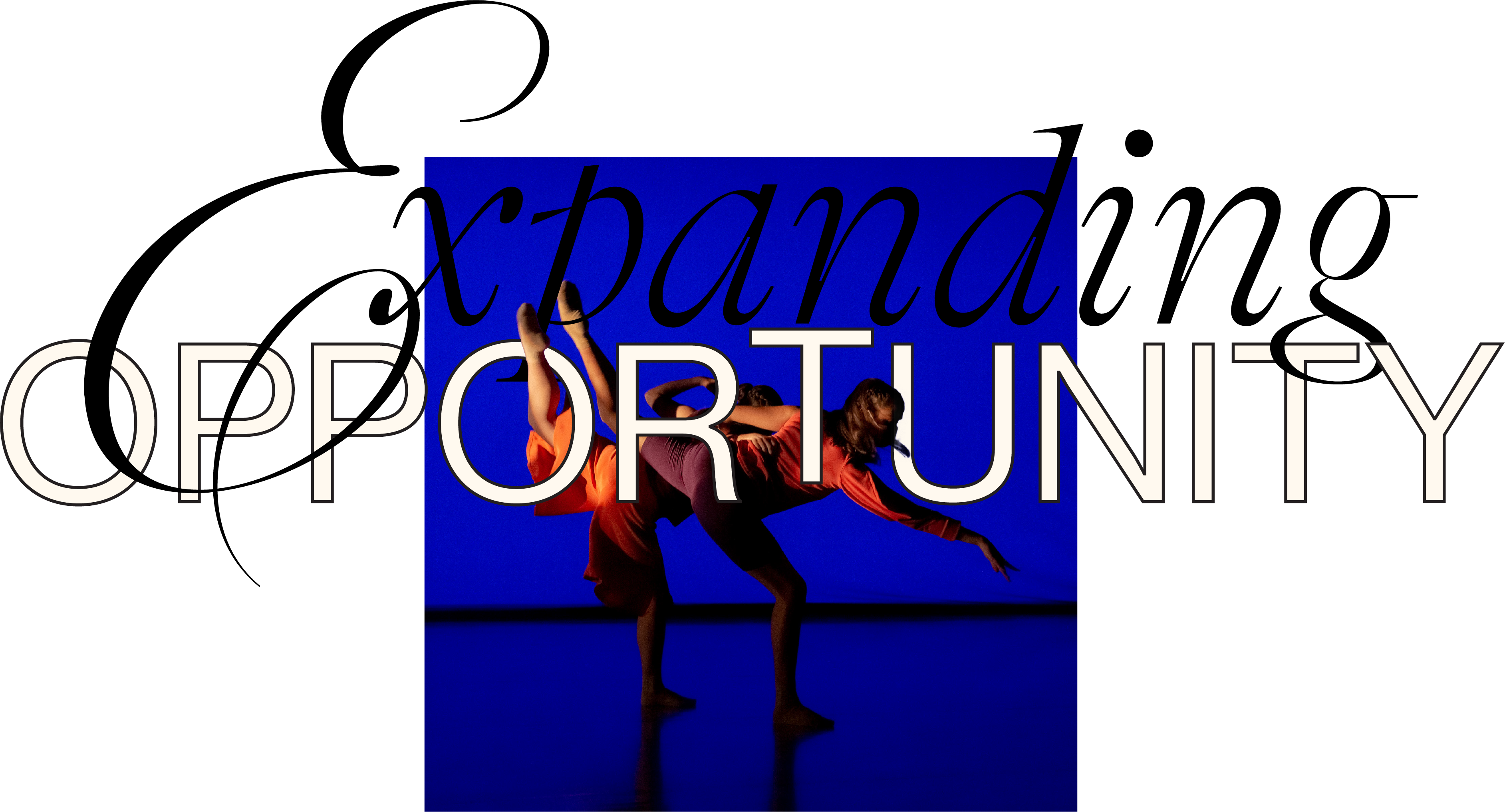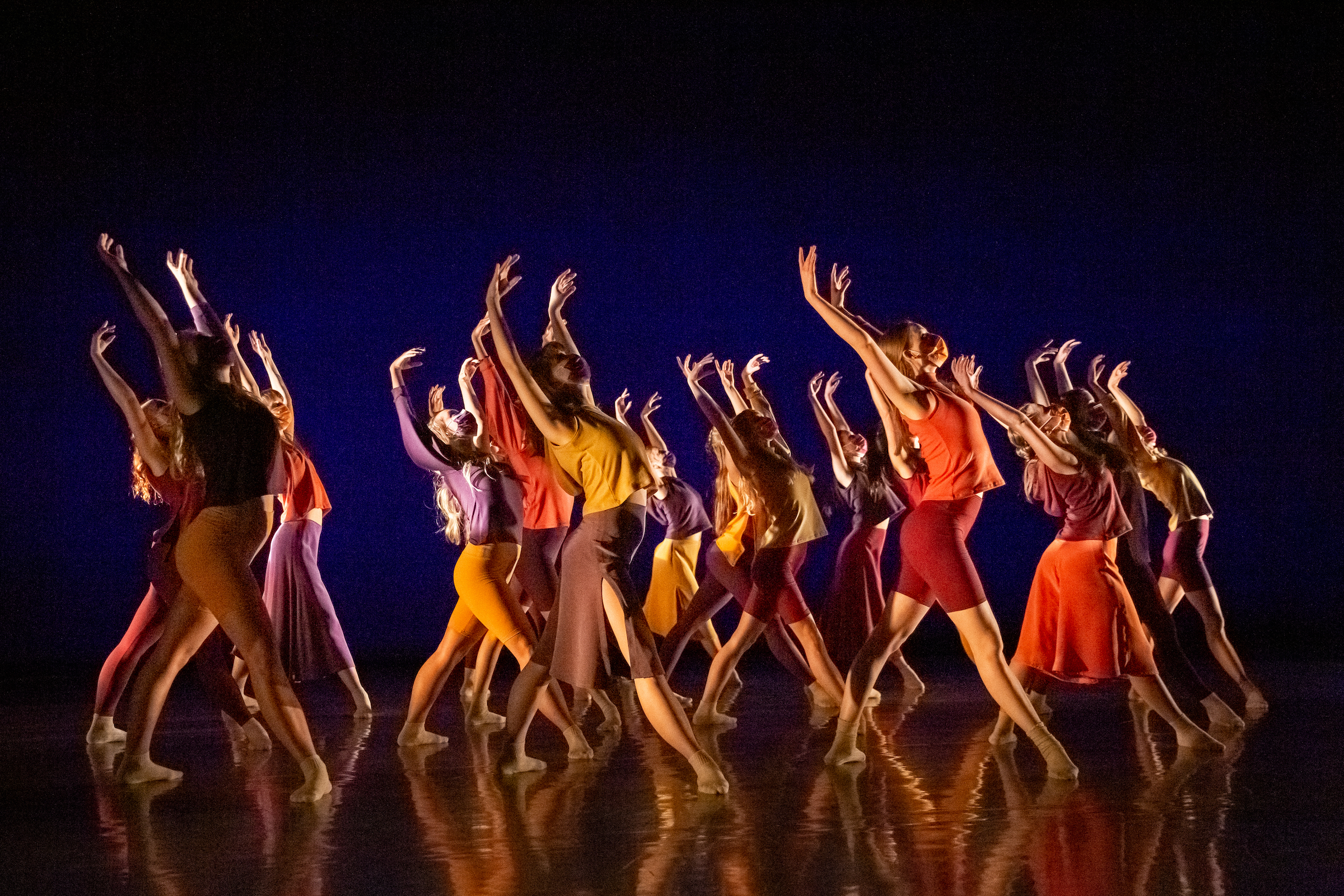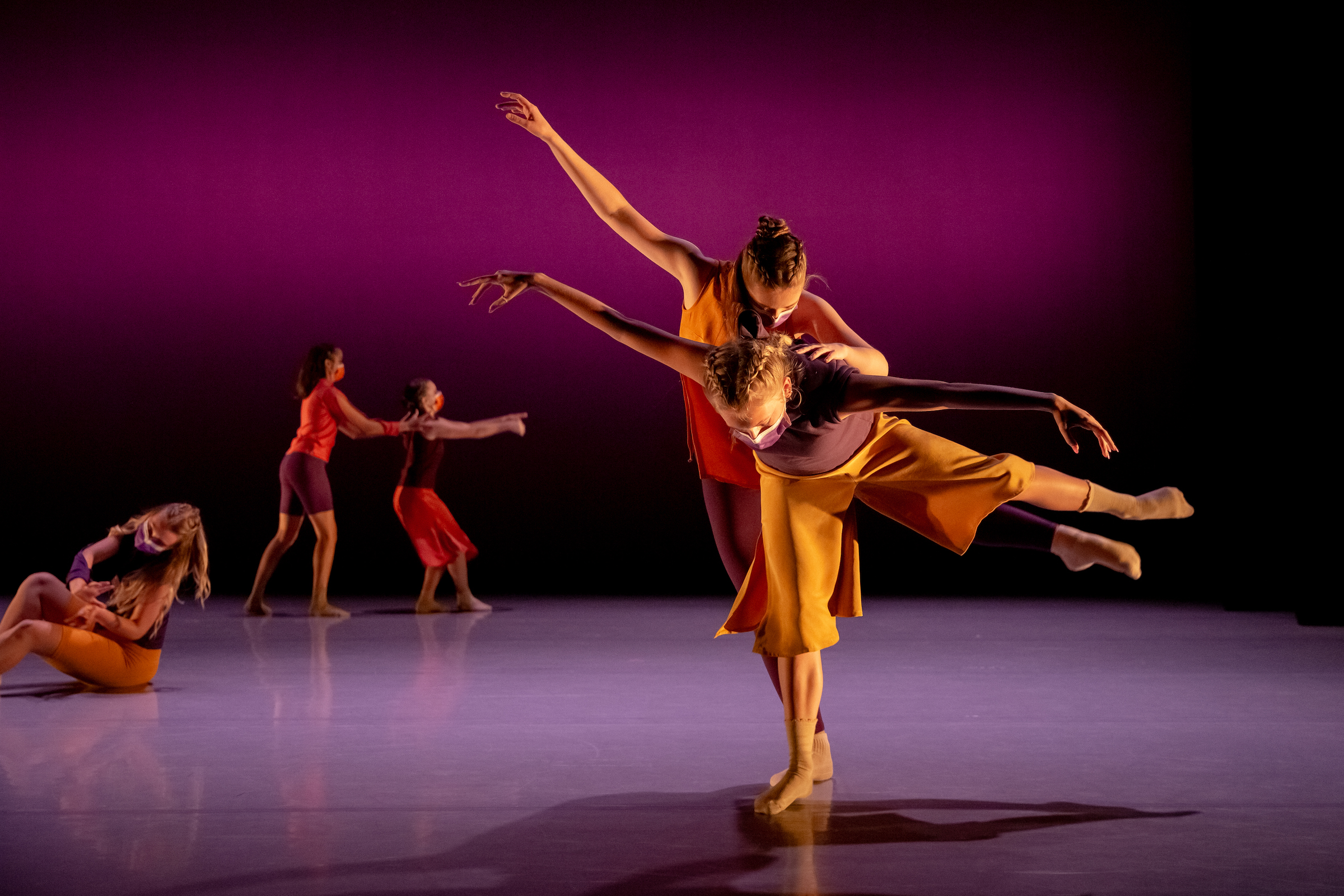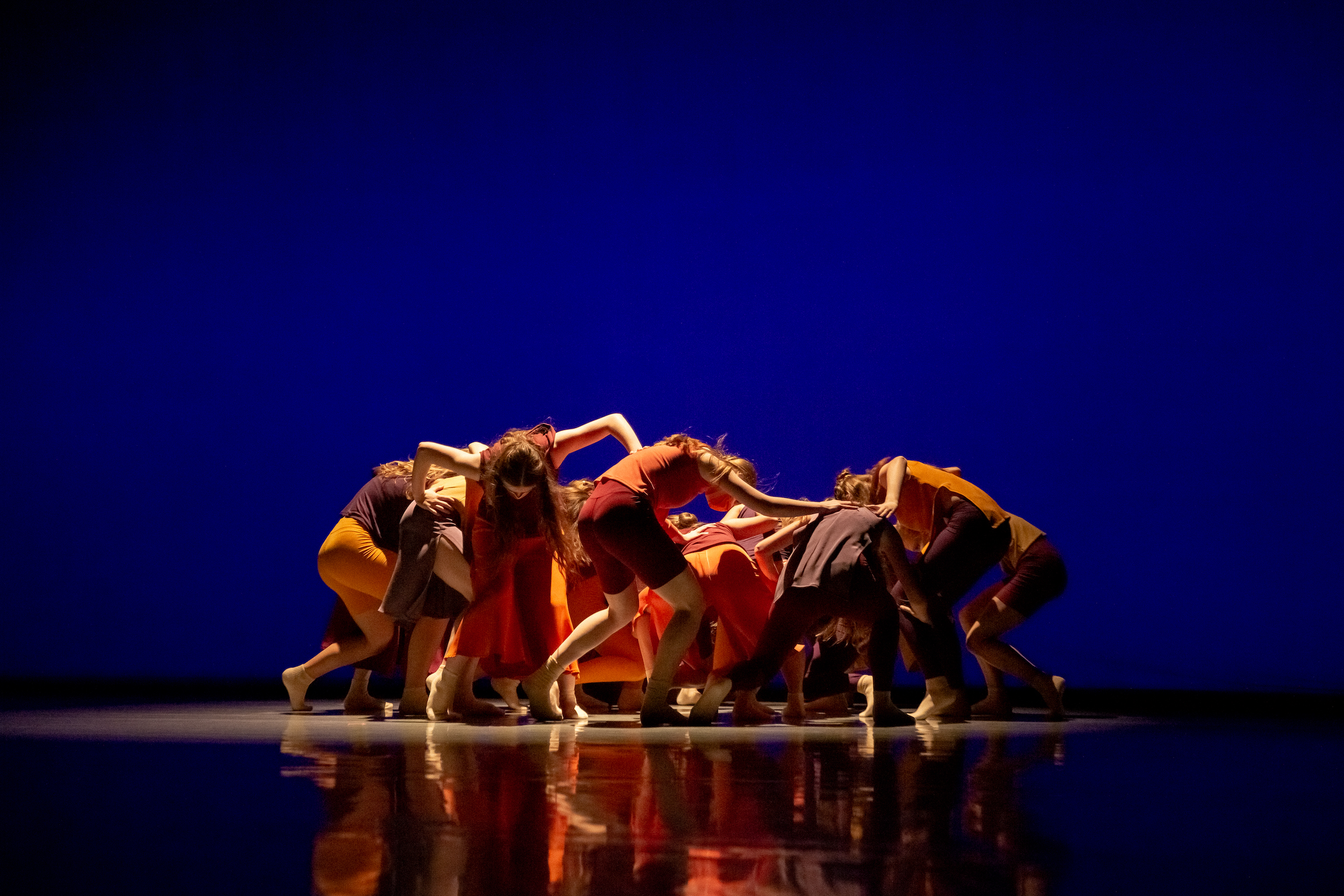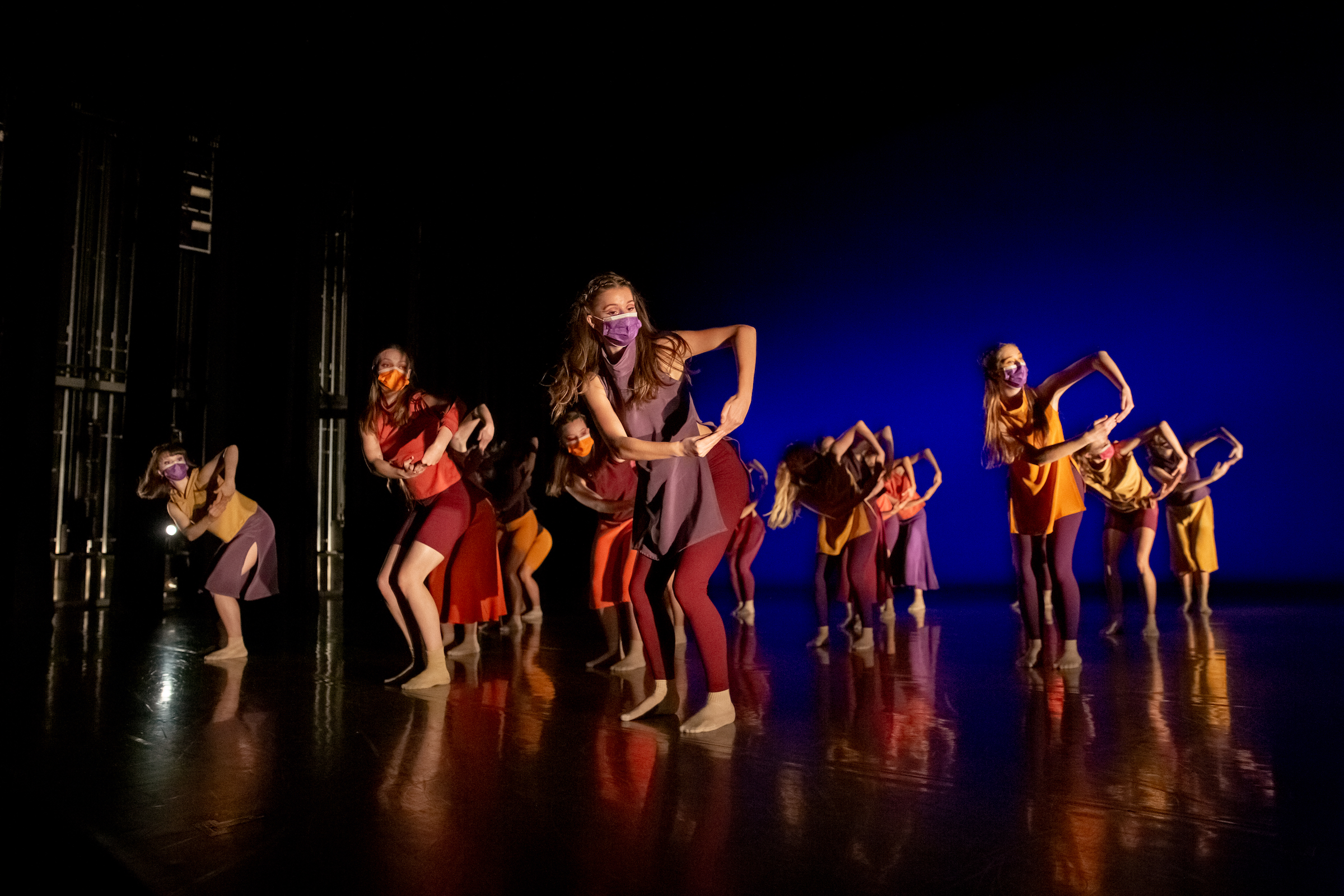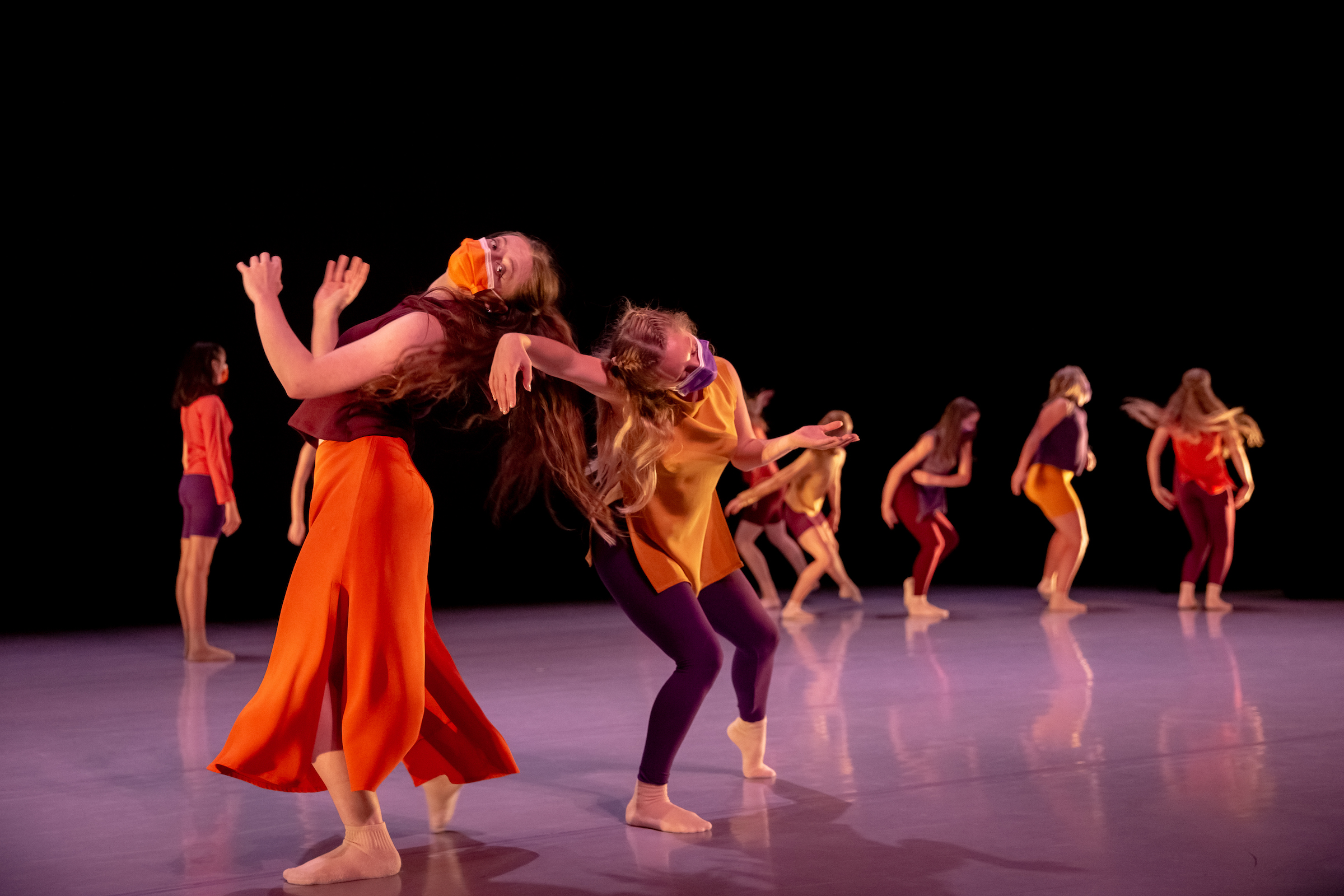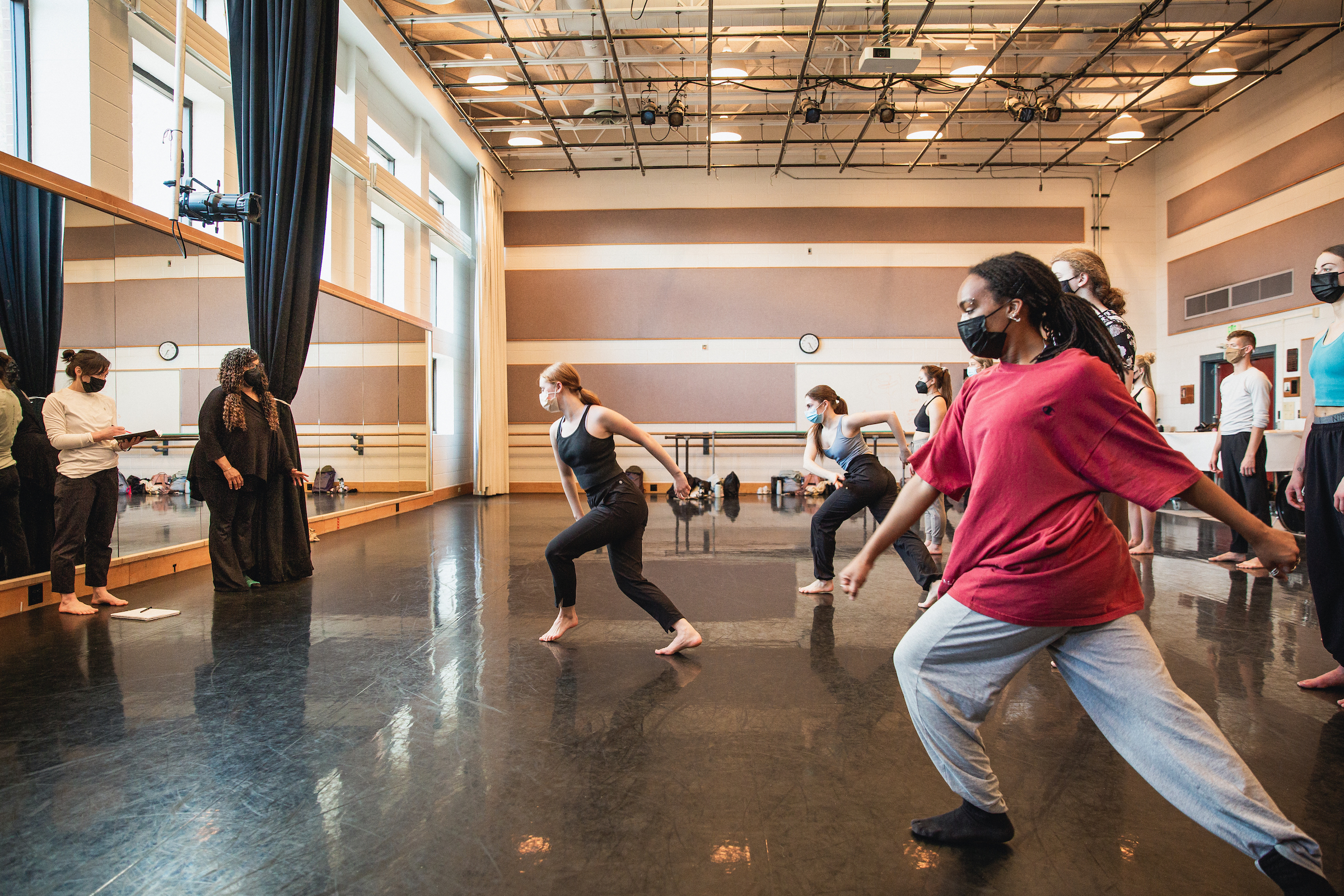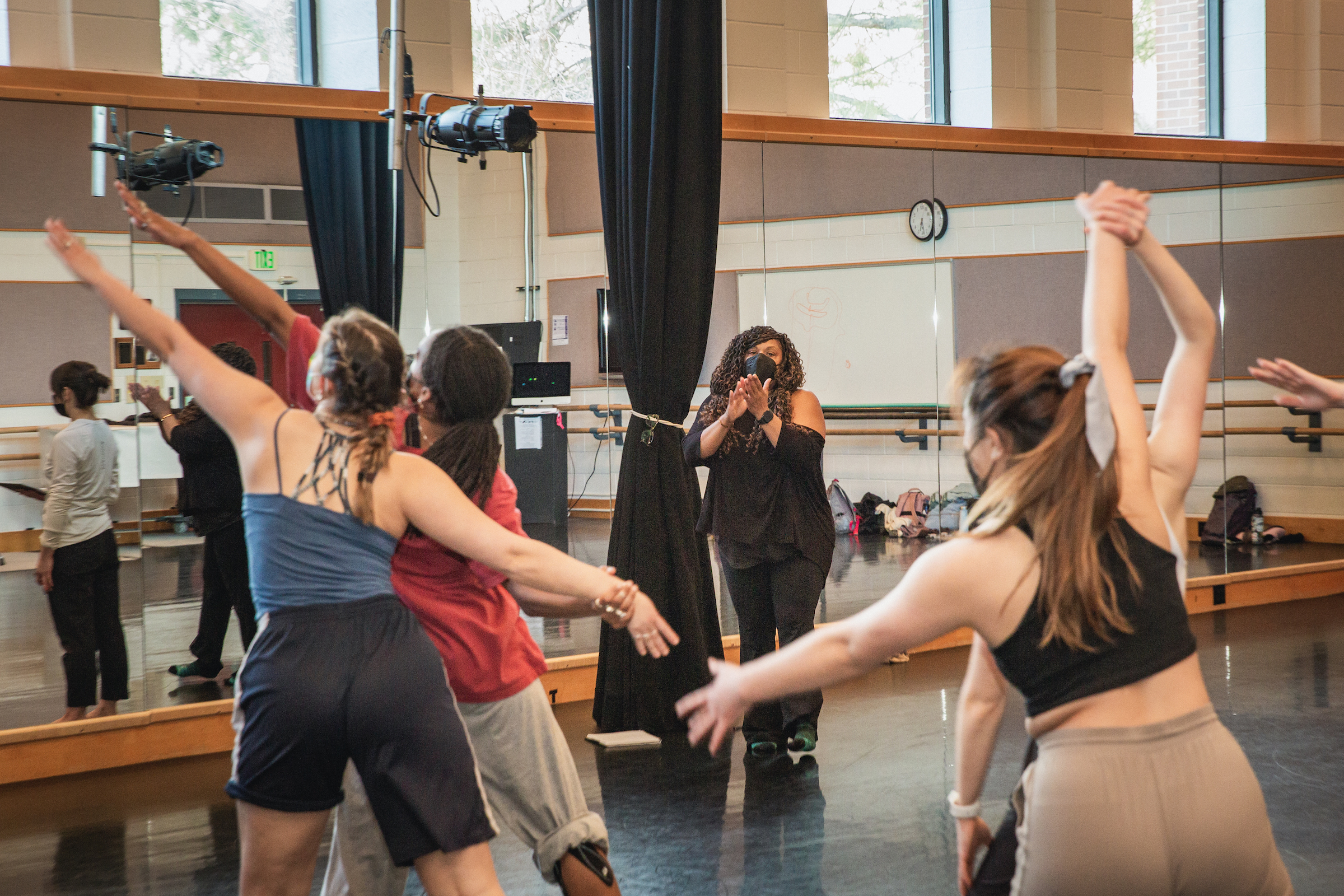(Above) Two dancers transition through movements in guest artist and alumnus Bashaun Williams' piece "The Next Chapter" which Williams described as being "about transitions. Transitions in life, transitions from one place to another, any and all ideas of what transitioning to something else can be.” (Photo: Todd Collins)
WRITTEN BY JULIA LYON
How guest artists are providing new choreography and new perspectives.
When Kevin Thomas came to the School of Dance as a guest artist this winter, students benefited from more than his years dancing principal ballet roles and expert teaching skills.
For many students, he also looks different than they do — and Thomas thinks that’s a good thing.
“It gives them another perspective,” he said. “And it makes them feel ballet is for everyone — it’s not just for one particular race that owns the rights.”
Thomas is among the guest artists teaching students and providing new perspective at a time when the School of Dance is reflecting on its past and exploring its future. Bringing in these professionals allows students to benefit from their unique experiences and imagine their own potential after graduation.
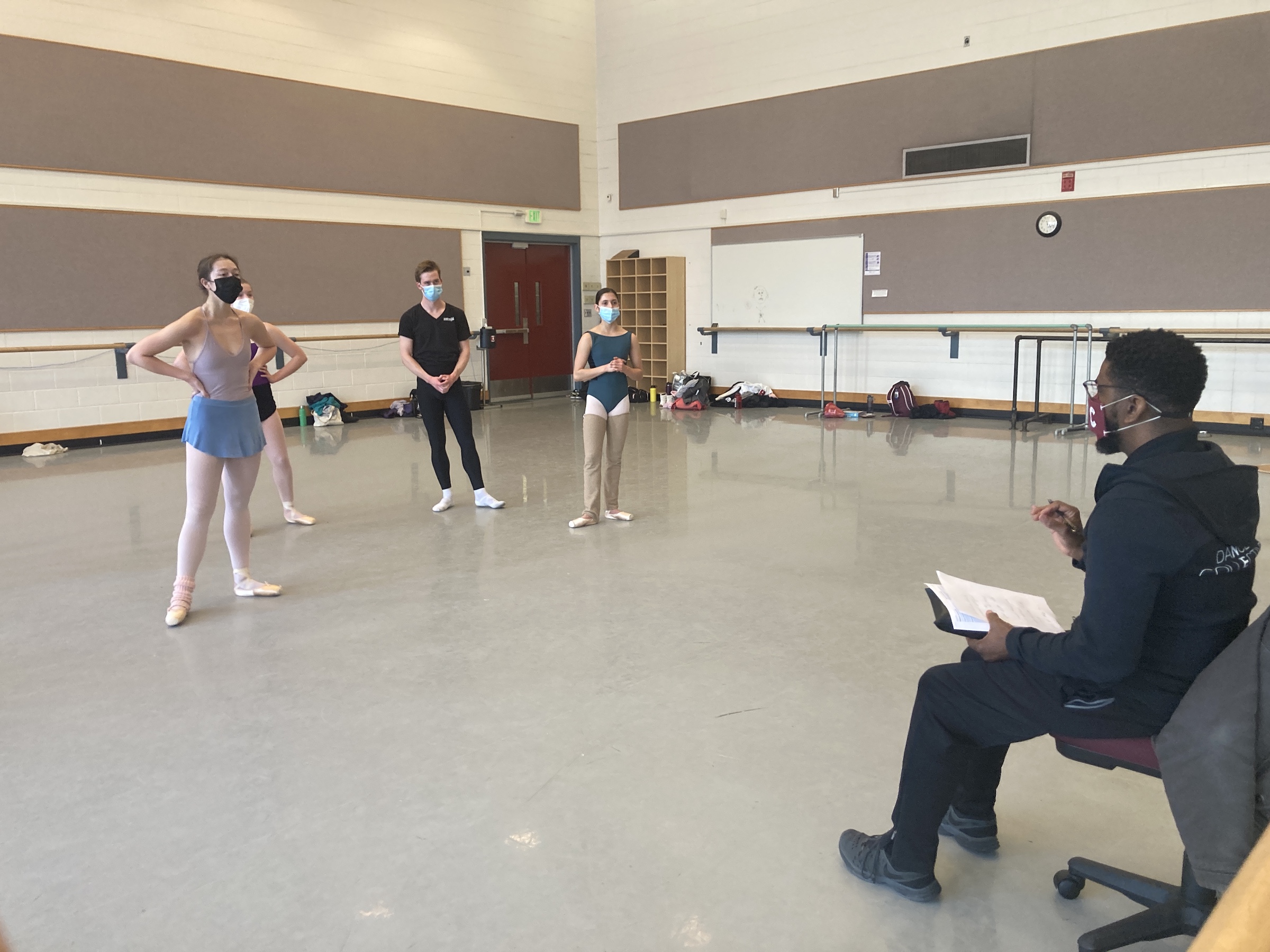
Guest artist Kevin Thomas, Director of Collage Dance Collective and former dancer with Dance Theater of Harlem, leading students in a masterclass for the Utah Ballet Summer Intensive. (Photo: Maggie Wright Tesch)
A co-founder of Memphis-based Collage Dance, Thomas is helping nurture a new generation of dancers at the Collage conservatory and breaking new ground with its professional company.
“When the kids see a reflection of themselves on stage, that’s when they know this is for them and they can do this,” he said.
Born in Trinidad and Tobago, Thomas grew up in Canada where he felt his career was limited because of his race. As a principal dancer with the San Jose Cleveland Ballet, he excelled. And when he joined the prestigious Dance Theatre of Harlem (DTH), Thomas had a realization.
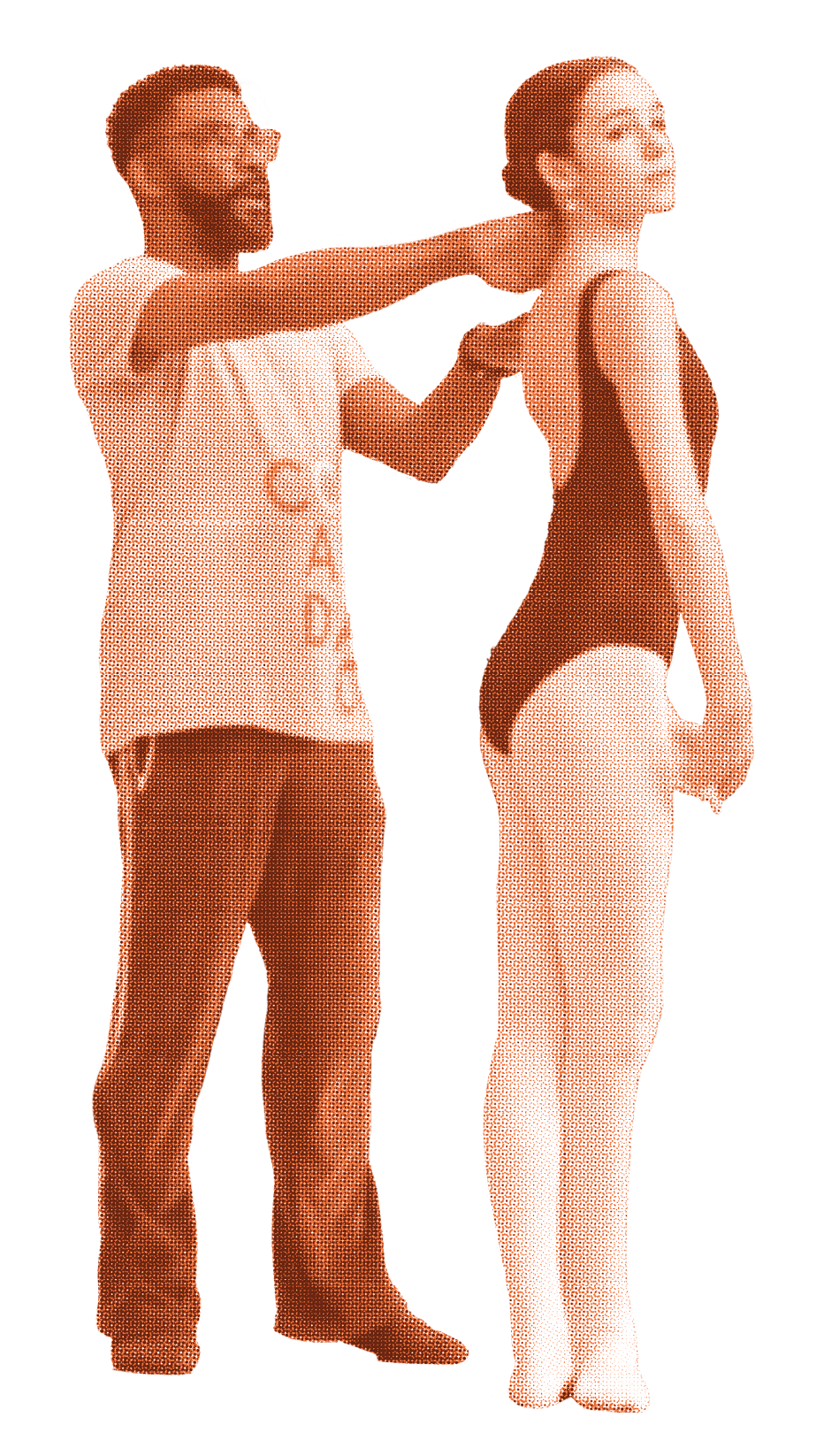
Born in Trinidad and Tobago, Thomas grew up in Canada where he felt his career was limited because of his race. As a principal dancer with the San Jose Cleveland Ballet, he excelled. And when he joined the prestigious Dance Theatre of Harlem (DTH), Thomas had a realization.
“Being on a stage of dancers that looked like me… I finally started liking myself as a dancer of color,” Thomas said.
His experience made him realize the country needed more companies like DTH, companies that could give young dancers role models. He believes Collage Dance is fulfilling that mission, while growing and diversifying ballet.
The School of Dance had already entered a period of self-reflection when Natalie Desch was hired as an Assistant Professor in 2019.
“Is this a place of inclusion where anybody can come?” she recalled of the discussion. “Are we really considering there are other ways of moving and stories that should be told that we need to give space for?”
She sees change happening now and change coming in the future.
“I think we’ve all not understood the systemic racism that has permeated this country and every aspect of it including our field of professional dance and the arts,” Desch said.
Thomas, who has taught School of Dance’s summer intensives for the past five years, has noticed an increase in students of color in the Utah summer program. He has also been struck by some of the instructions he received over the past few years: partner men with men and women and women, not just men women — as is traditional in ballet.
The world is changing and so is dance.

Natosha Washington (’04), a School of Dance graduate who returned as a guest artist this spring, has used her choreographic voice to address injustice in America. In 2018, the death of a relative gunned down by police officers in Georgia moved her to create “Say Their Names,” performed by Repertory Dance Theatre.
A modern dance choreographer based in Salt Lake City, Washington teaches dance at West High School where the representation of diverse communities in Utah shows up in her students that are Latinx, Polynesian, Asian, Black, African, and Indian among many other diverse backgrounds.
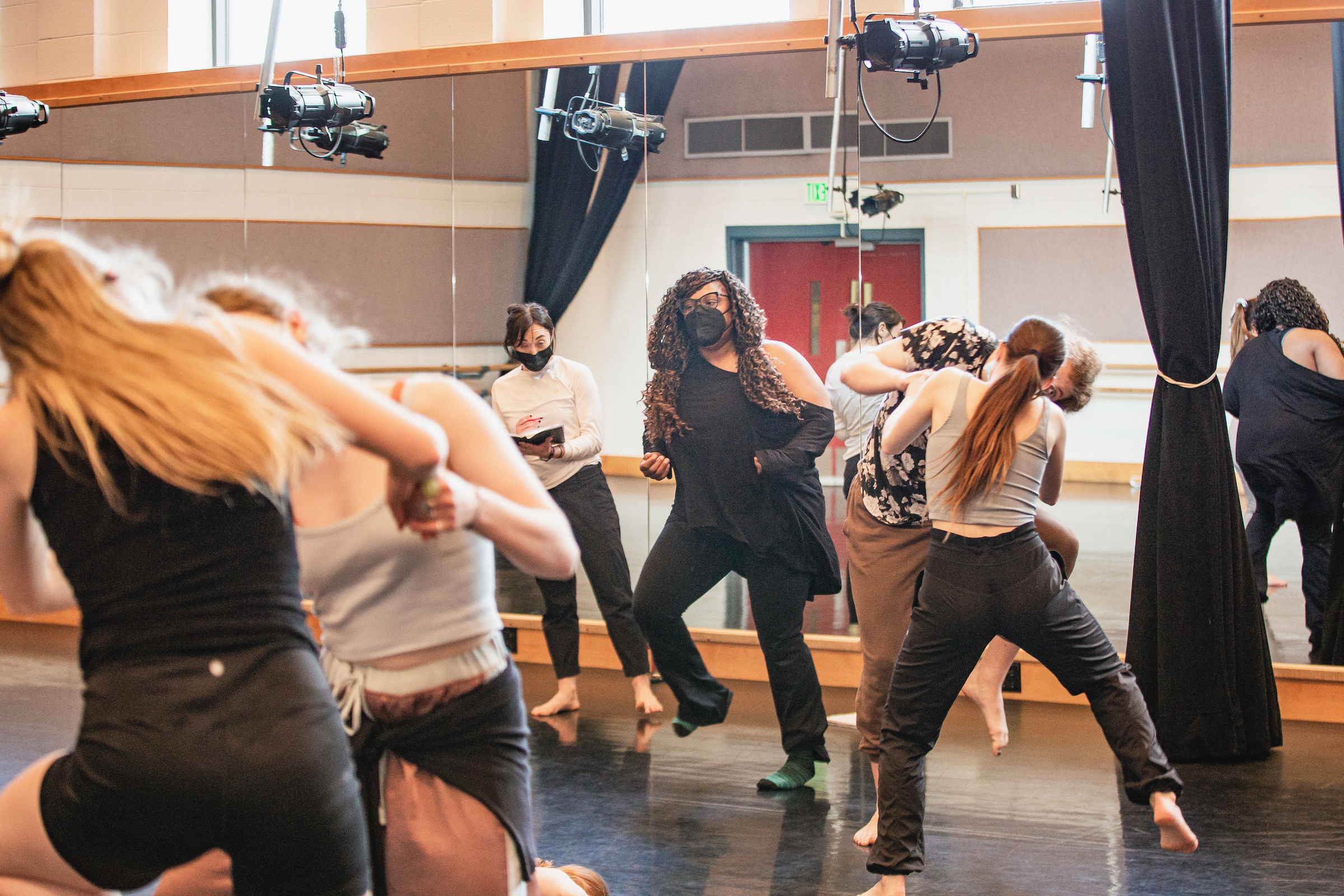
Guest artist and alumna Natosha Washington in rehearsal with the cast of her premiere work “The World In Reverse,” which Washington said visually explores the thought that, “every night I dream of a place. A world that was made for me. I’m beginning to lose faith in dreams.” (Photo: Todd Collins)
“Because of that, I feel like it’s really important to make sure that students are getting classes that they can relate to in terms of movement,” Washington said. “We don’t just teach Eurocentric dance forms here — we give them as much as possible in terms of bringing in guests as well.”
Originally from Georgia, Washington came to Utah 22 years ago and noted there was much less diversity. “I could go weeks without seeing another Black person,” Washington recalled.
Her time at the School of Dance was “amazing,” but few people of color were on the faculty — a reality still true today which makes Washington’s presence incredibly important, although not the comprehensive solution to the problem the School of Dance is working toward. One of those faculty members was Kaye Richards, an incredible mentor and teacher.
“When I did my homework, I would sit outside Kaye Richards’ door… she would invite me in,” Washington remembered. “She was someone who looked like me, who I knew had stories like me.”
“It’s not that I don’t think students of color won’t go talk with a teacher who is White,” she said. “Representation breaks down barriers that are hard for a student to break through.”
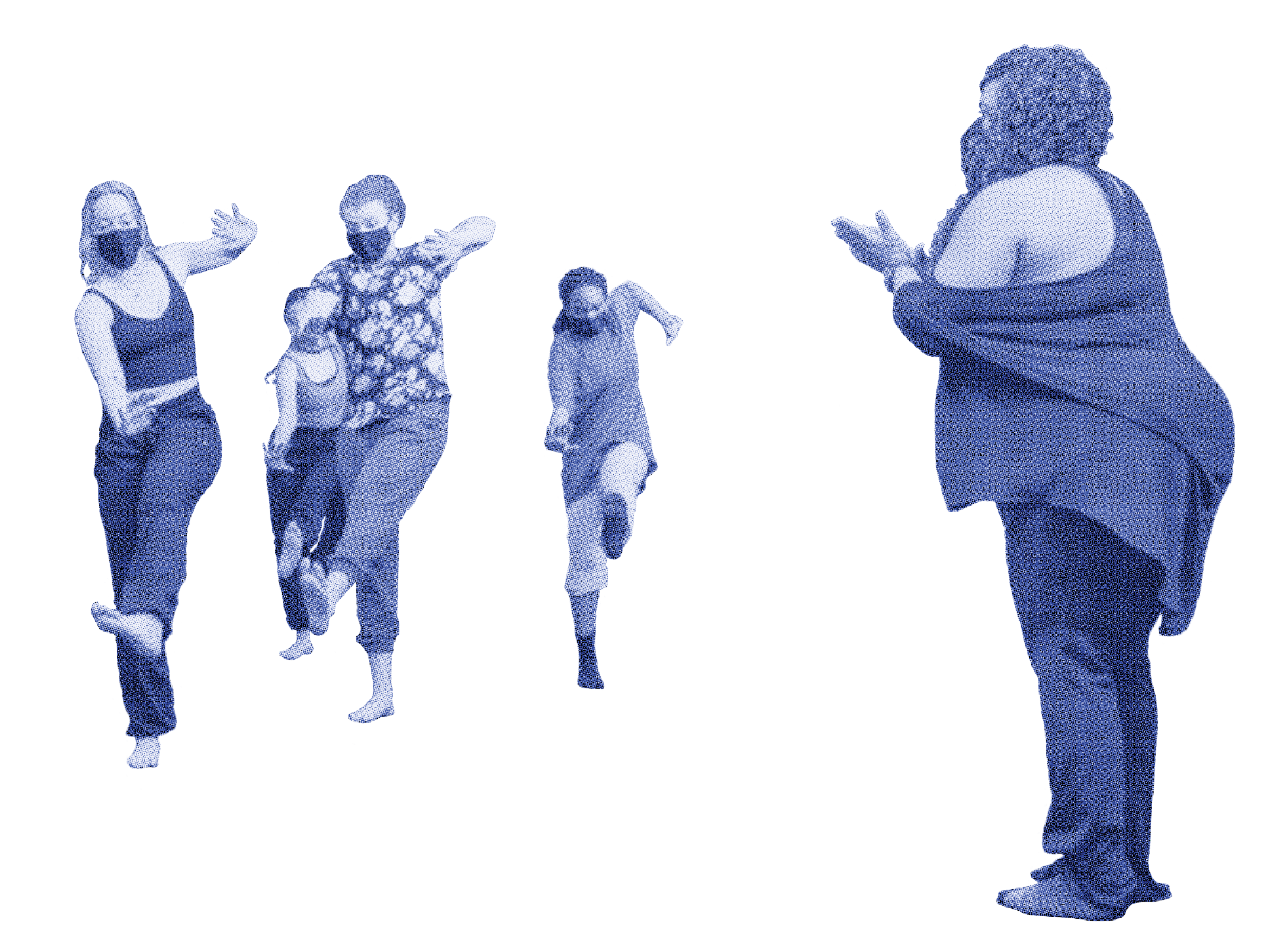
Washington explained her philosophy about the impact dance can have.
“I’m passionate about dance, but I’m more passionate about building community through it,” she said. “Making sure that students get to interact, feel seen, heard, and valued no matter what their backgrounds are.”
Bashaun Williams (’11), also a School of Dance graduate, embraces a process that many in ballet would consider unorthodox.
When he set new choreography on University of Utah ballet students as a guest artist last fall, they listened to a mix of hip hop, gospel, movie soundtracks, Kanye West, and more during rehearsal.
“With my movement style, since I do have a ballet background, I draw from that foundation — but I like to consider myself more of a ninja,” he said. “I try to blend those styles together. One thing I really like to do is throw on hip hop music when we’re in the process and see how that changes the approach to the movement.”
The name of the piece he created became “The Next Chapter.” After 10 years with Ririe-Woodbury Dance Company, he felt like he was at a major transition in his life and career.
He hopes that he showed the School of Dance students what it’s like to choreograph an original work, something he rarely got to do as a student. Williams is a strong believer in collaboration.
He remembers how, as a dancer with Ririe-Woodbury, being part of the process was when he learned the most. As a highly experienced dancer now, he knows that trial and error and finding solutions to movement problems are valuable tools.
“It might for the first couple of days feel like we’re playing around,” he said of his work with the students. “But then, after we have all the vocabulary we need, we can sit down and pick out all the right words to write the story.”
And what was the result?
“I would call every dance I make a ballet even if what you’re watching isn’t what you would consider ballet,” Williams said. "It's never about the actual steps. It’s about the feeling the dancers bring to them.” ▪


